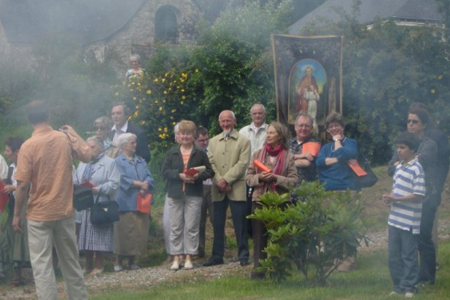 |
||||||||||
 |
||||||||||
|
1485: Sainte-Brigitte, Côtes-d'Armor, France Mystery Worshipper: Abed-Nego. The church: Sainte-Brigitte, Côtes-d'Armor, France. Denomination: Roman Catholic. The building: There is a good reason why the village of Sainte-Brigitte and the church share the same name. The church is the dominant building in this very small community in the heart of the Breton countryside. Although the church is a mish-mash of 18th and 19th century styles, it is a light and well-proportioned place of worship seating around 100. The church grounds (including a sizeable graveyard) are very well kept, and a large playing field separates the church from the modern parish house. A very large crucifix hangs outside the main entrance. The church: I would think that at least a third of the modest population of Sainte-Brigitte (listed as 166 in the 1999 census) attended this service, and though there was a predominance of elderly couples, there was also a fair number of young families including rather well-behaved children. The neighbourhood: Côtes-d'Armor lies on the north coast of Brittany. Its rugged coastline is dotted with quaint, medieval towns. There are two really good things about the village of Sainte-Brigitte: a bar which doubles as a crêperie and serves the best pancakes in the area, and a British pub(!) hosted by a friendly couple of emigres (and their eccentric dog) from Northamptonshire in England. Both establishments are less than 20 steps from the church. The cast: No way I could find out the names of the good monsignor who celebrated mass or the attractive lady organist – who later doubled on the fiddle! There was no bulletin. Nor is there a parish priest assigned to Sainte-Brigitte. The date & time: Sunday, 15 July 2007, 11.00am. What was the name of the service? Pardon et Kermesse, a religious service unique to Brittany. The words defy translation; "pilgrimage and festival" probably say it best. How full was the building? Pretty nearly full. Did anyone welcome you personally? No one welcomed our little party of three. In truth, we were the first people to enter the building, though we arrived only 15 minutes before the service was scheduled to start. At 11.00 precisely, an orange hymn sheet and several blue scraps of paper were unceremoniously pushed into our hands. The latter contained announcements of upcoming events in the five neighbourhood parishes, along with a short biography of Blessed Anne-Marie Javouhey (1779-1851), founder of the Sisters of St Joseph of Cluny, whose feast day it was. Was your pew comfortable? A bit cramped, but manageable. How would you describe the pre-service atmosphere? There was a mighty crescendo of unbroken noise and chaos from the time we walked in off the street until the mass began. At 10.45 the place was absolutely silent and deserted. Five minutes later things started to liven up. The organist began to warm up her very stiff fingers on an appallingly loud electronic organ. She worked her way through several equally ugly and impossibly loud registration possibilities. Then the old priest came in and they greeted one another like best friends. Next to enter were a lady cantor and two other "musical associates" about whom I'll have more to say later. The cantor and the organist tried out a few of the musical highlights-to-come; she had a nice sort of sing-along folksy voice. Meanwhile, the congregation drifted in, and at 11.00 on the dot the priest, fully vested for mass and wearing a monsignor's biretta, entered and sat down near the altar. But at this point, what had seemed like disorganized restlessness metamorphosed into earsplitting chaos! Someone decided to test the audio system, and the feedback was terrifying. Several attempts were made to quell the infernal racket, but in the end the audio man simply walked away, apparently hoping we'd get used to the noise. At 11.07 the good monsignor, whose nerves were probably as badly shaken as ours, rose – and the mass began. What were the exact opening words of the service? Au nom du Père et du Fils et du Saint-Esprit. What books did the congregation use during the service? Just the orange sheet of hymns – which was not organised in linear fashion. Little scraps of text in at least ten different typefaces wandered around the paper (no musical notes). Good thing we knew enough French to get us through. The Breton words on the second page were a bit of a mystery – but we'd soon find out what they meant (see below). What musical instruments were played? The really ugly "toaster" organ – and for the procession, a fiddle played country-style, no vibrato. Did anything distract you? Where to start? Let's begin with the orange hymn sheet, which looked as though it had been produced by clipping the words to hymns from a variety of sources, taping them haphazardly to a piece of paper, and photocopying it. Here in the Breton countryside, folks apparently take the home-spun approach to the science of communication. And then there was the reading of the epistle. The lector was a lady from the congregation who made me nervous simply by daring to approach the microphone which had erupted so violently during the warm-up proceedings. She kept her distance, though, making no attempt to project her voice, and our eardrums survived intact! The funny thing was that she dragged her four-year-old to the lectern with her for the reading. It was difficult to pay attention to her words since her offspring drew all eyes with his soulless stare of bored indifference. (The good monsignor had no need of the microphone – his unamplified voice projected very nicely, thank you.) Was the worship stiff-upper-lip, happy clappy, or what? It was neither stiff, nor upper-lip, nor happy, nor clappy! How about "folksy-wolksy?" But in an ecclesiastical sort of way. Instead of the Kyrie, gloria, credo, etc., the cantor led us in some modal ditties that sounded like English folk songs that weren't quite interesting enough to make the final cut in folklore revivalist Cecil Sharpe's anthology. The poor cantor girl seemed to have to cope with all kinds of pitches that were at the extreme ends of her vocal range, and I must say she did so very good-naturedly. (Clearly the toaster-organ lacked a transpose feature and the organist did not number it among her accomplishments.) The congregation gave everything their best go. By far the happiest musical moment was an a cappella trio just after the Agnus Dei, sung by the organist-turned-soprano, the cantor, and one of the "musical associates" mentioned above, a quite serviceable tenor.  Exactly how long was the sermon? 14 minutes. On a scale of 1-10, how good was the preacher? 6 – I suspect the monsignor was around 80 years old. He was obviously well-practiced in the science of preaching. Although my French is not good enough to understand everything he said, I think I followed him for the most part. In a nutshell, what was the sermon about? He began with highlights from the life of St Brigitte and the many blessings she had bestowed upon the parish (he read this part verbatim from notes). Then he took up the theme of the gospel reading for the day, Luke 10:25-37, the parable of the good Samaritan. Who is our neighbour? He reminded us that all the world was our neighbour and pointed out that we are someone's neighbour when we step up to help them. Which part of the service was like being in heaven? Receiving holy communion was quite the most heavenly part of the whole experience. To be a part of a Christian fellowship thousands of miles from my home, if only for a brief moment, to share the Blessed Sacrament with believers whose traditions and language are far removed from my own, and to feel the nearness of God's presence and the power of his love in a place where I didn't know a single soul on a personal level – surely all this is a foretaste of heaven itself. And which part was like being in... er... the other place? And now for the final "musical associate," a pretty little 12-year-old girl who had been corralled into singing something while the plate was passed at offertory time. She looked rather unsure as the organ played the introduction to her number, but once she realised the inevitability that she would have to be heard in public, all self-confidence flew out of the church and into the high street of Sainte-Brigitte. The song began with a strangulated squeak of indeterminate pitch. The organist wasn't going to give up so easily, though. She grabbed the mike from the soloist and, while continuing to play the accompaniment with her left hand, pointed the mike toward the girl's throat. But the poor child could manage nothing resembling a recognisable melody. Rather than abandon the idea of an offertory song entirely, the organist tried to encourage the girl by singing with her. This only made matters worse. And so we were treated to an offertory motet consisting of a left-hand-only accompaniment on a very ugly organ, a flustered organist singing off-mike, and the toneless croaks of a pre-pubescent girl in a paroxysm of stage-fright. Eventually the girl pushed the microphone toward the singing organist's mouth and gave up entirely! What happened when you hung around after the service looking lost? There was no opportunity to hang around. No sooner had we heard the dismissal than the organist took up her fiddle and led us out into the bright, sunny air and on our way to – well, I wasn't at all sure where we were going. Out through the main door, into the street, past the crêperie, down the hill, across the main road, and into a field we danced, following the erstwhile pied fiddler. Now the purpose of those words in Breton on the other side of the orange sheet became clear. They were the words to a hymn in praise of the village's patron saint – no longer Sainte-Brigitte but Santez Berhed. At the bottom of the meadow there was a spring of water and nearby a large pile of brushwood. The monsignor said some prayers and then asperged the brushwood with holy water, whereupon the village pyromaniac set fire to the whole thing. (Of course, I don't know that he was a pyromaniac, but since we had seen this same ruddy-faced chap in several local hostelries, we conveniently invented this fiction to amuse ourselves!) Fifteen feet of dry wood piled high were soon creating a fine blaze, and firecrackers secreted within the conflagration provided a joyful climax to the celebration. We followed the lady fiddler back toward the church hall singing the praises of our Blessed Lady in French: Vierge Sainte, Dieu t'a choisi, depuis toute éternité, pleine de grace, nous t'acclamons. How would you describe the after-service coffee? Everyone seemed anxious either to get on with the fun and games scheduled to take place that afternoon on the playing field – a boules tournament (the French version of lawn bowling) was to provide the early-evening climax for this event – or to raise money by selling boxes of rather delicious home-made cakes. We succumbed and washed down our sweetmeats with a glass of kir (a cocktail of black currant liquor and white wine). All very civilised! How would you feel about making this church your regular (where 10 = ecstatic, 0 = terminal)? 2 – We are unlikely ever to make a permanent move to this part of the world. But on the chance we should, I think we would look for a church in one of the larger towns of central Brittany. Did the service make you feel glad to be a Christian? Oh yes! Everything seemed a bit chaotic and extemporised, but I'm sure everyone's heart was in the right place. What one thing will you remember about all this in seven days' time? That our quest for a simple eucharistic service (we discovered that many of the churches in the region remain locked up tight despite mass times being listed on the notice boards) resulted in our stumbling upon a Pardon et Kermesse! |
|
|
||||||||||||||||||||||||||||||||||||
| More Mystery Worshipper reports | |||||||||||||||||||||||||||||||||||||||
 |
|||||||||||||||||||||||||||||||||||||||






